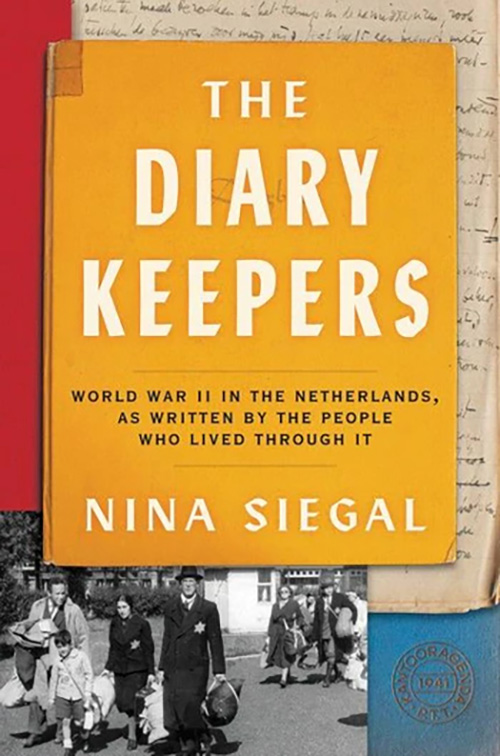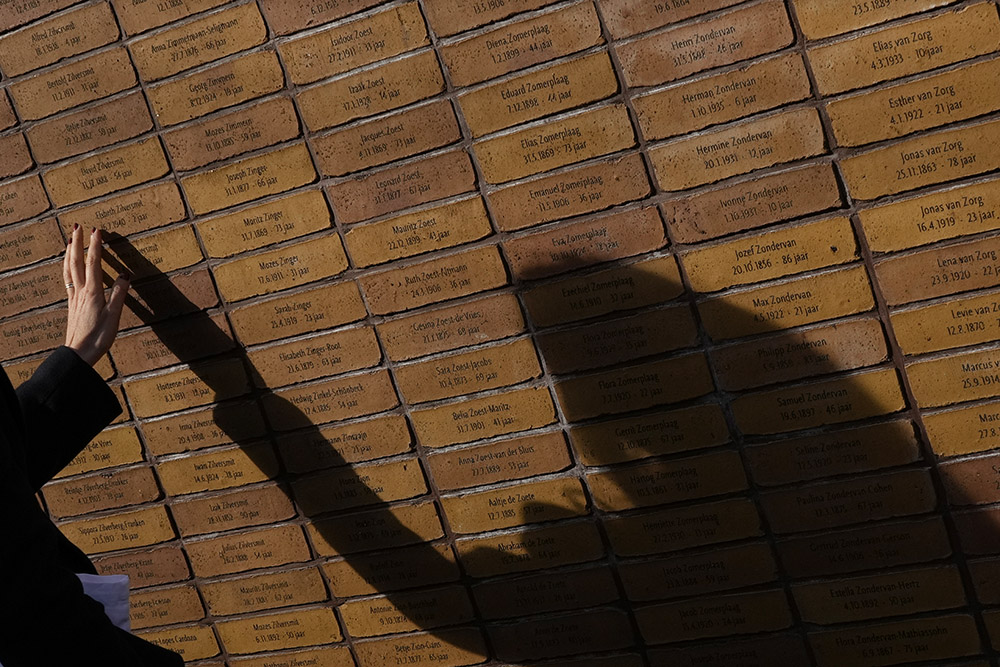
Amsterdam Jews await deportation to the Nazi transit camp in Westerbork, the Netherlands, on June 20, 1943. A member of the German Security Police can be seen at right. (Wikimedia Commons/Netwerk Oorlogsbronnen/Herman Heukels)

During my return to Poland from a February assignment in Ukraine, I jotted down the names of Polish cities I passed through on a train from Kyiv to Warsaw: Deblin, Lublin and Otwock, for example.
I later looked them up online and found that the histories of each are punctuated by stories of roundups, murders and deportations during World War II — not to mention betrayals by non-Jewish Poles turning in their Jewish neighbors to authorities.
Similar yet lesser-known histories haunt other countries, but the reckoning in those locales has been slower to come. That fact partly undergirds Nina Siegal's The Diary Keepers: World War II in the Netherlands, as Written by the People Who Lived Through It.
Siegal, a New York-born journalist and novelist who lives in Amsterdam, presents readers with translated excerpts from journals penned principally by seven Dutch diarists, tracking their lives as the five-year (1940-45) German occupation unfolded. The diaries are part of a collection of thousands of journals gathered by the NIOD Institute for War, Holocaust and Genocide Studies in Amsterdam.
This moving and often riveting book is a revelation, providing a glimpse into life under Nazi occupation. At once epic and intimate, it merits comparison to Marcel Ophuls' classic 1969 documentary about life in occupied France, "The Sorrow and the Pity," which recently had a revival in New York City.
Personal depictions of war are both timely and urgent, for war tells us something about the human condition.
Siegal's diarists include a Dutch general store owner who joined the resistance and helped hide and protect Jewish citizens, two Dutch Nazi sympathizers and a Jewish journalist who meticulously recorded the day-to-day life in a transit camp where Dutch Jews were held before being sent off to their deaths in locales like Auschwitz. (Siegal made a conscious choice not to include excerpts from worthy but already-published and well-known diaries, such as that of Anne Frank.)
Interspersed with these narratives are Siegal's able historical context for the journals and her own personal reflections. Siegal herself is a "second-generation" Holocaust survivor, who wondered why talk of her Czech grandfather's life before immigrating to the United States was often met with uneasy silence.
The personal is important here — but so is the greater, wider context of wartime (and postwar) Dutch history.

The city of Rotterdam, the Netherlands, after German bombardement in 1940 (Wikimedia Commons/Rijksdienst voor het Cultureel Erfgoed)
There is not any single answer as to why German forces rather easily occupied the Netherlands despite initial courageous resistance by Jews and non-Jews, including urban workers. One answer may be that the city of Rotterdam was largely leveled by German bombing, and the Dutch capitulated out of fears of further destruction, a view argued in an arresting 35-minute colorized video of the occupation's early days available on YouTube.
Of course, there was the very real fear factor. The war was not merely a military conflict, Siegal notes, but its "ideological violence played out in urban centers, in public squares, on public transportation, and inside businesses and homes. Often, it was characterized by civilian betrayals among neighbors, even within families."

German police round up Jewish men at Jonas Daniël Meijerplein, a square in Amsterdam, in February 1941. (Wikimedia Commons)
Another key element was the complicity of Dutch authorities and what one observer describes as "the ferocious hunt for Jews." A Dutch historian told Siegal that a majority of the Amsterdam police participated in roundups. Postwar testimony indicated that "not even ten percent of the country's Jews would have been captured" without the involvement of the Dutch police.
The numbers are certainly damning: Nearly three-quarters of the Dutch Jewish population perished in the Holocaust — one of the highest percentages in all of Europe, edging close to Poland's astonishing 90%.
This fact goes against what for years was the accepted postwar narrative in Holland: that the Dutch bravely resisted the German occupiers and helped Jewish neighbors, like Anne Frank's family.
That uneasiness — a kind of cultural dissonance — is something that Jewish residents in the Netherlands feel keenly.
"Something was deeply troubling about Jewish life in the Netherlands," Siegal writes.
A fellow New Yorker living in Amsterdam agreed, telling Siegal: "They say that the Dutch Jews are still in hiding." (Siegal, though, commends recent Dutch efforts to grapple with the past, such as establishing a striking Holocaust memorial in Amsterdam.)

A woman touches the name stones of Holocaust victims of the Zilversmit family after the unveiling of a new monument in the heart of Amsterdam's historic Jewish Quarter on Sept. 19, 2021, honoring the 102,000 Dutch victims of the Holocaust. (AP/Peter Dejong)
Some gentiles did display courage, as attested by the diary entries of general store owner Elisabeth van Lohuizen in the town of Epe. Van Lohuizen was aware of the risks she and friends and family were taking in hiding Jewish residents. But she remained steadfast, drawing from her own Liberal Dutch Reformed Calvinist faith for sustenance. (She and her family were later honored in Israel as "Righteous Among the Nations.")
Van Lohuizen wrote in July 1942 of the deportations to Poland: "Why, oh why, do they bring such tremendous suffering to this group of God's children?" Later that month she wrote that Jewish lives "are just as valuable as ours; we must help, and not be afraid."
Such empathy is in marked contrast to other diarists. One is Douwe Bakker, a zealous anti-Semite and an ambitious Amsterdam police detective intent on pleasing his German overseers. In speaking of early violent Jewish resistance, Bakker wrote of "hundreds of mad Jews" and "the horde of Jewish beasts."
Advertisement
But for me what lingers in the memory is not Bakker's mocking and bigoted bravado but the entries of Inge Jansen, the pseudonym for a Dutch socialite married to a physician eager to ingratiate himself with the Nazi medical establishment. Her entries — recording a life of social engagements, teas and a kind of hazy wartime languor — hint of the sad vacuity and emptiness of a life spent among the German occupiers.
By contrast, the moral center of the book, aside from the entries of van Lohuizen, is the painfully etched testimony of Philip Mechanicus, a Jewish journalist who chronicled life at the Westerbork transit camp in northeastern Holland.
Mechanicus' wife, who was not Jewish, survived the war. Mechanicus did not. Forced to leave Westerbork in March 1944, he eventually perished at Auschwitz.
His diaries were once available in English in a single volume, though they have long been out of print. So we owe thanks to Siegal for reviving attention to Mechanicus' achievement: the brave witness of a gifted journalist who wrote movingly and gracefully about probing existential concerns as well as the small details of camp life.

A photo of Philip Mechanicus circa the late 1930s, and a page of his diary from May 28, 1943 (Wikimedia Commons)
"Whoever has the courage to look life in the eyes must also have the courage to face death," Mechanicus wrote in July 1943.
Later in the year, he said it was his calling "to record the daily goings on here for those in the future who will want to have a picture of what happened here. That's why I have a duty to continue writing."
Hope against hope. Mechanicus's death and his disappearance from Siegal's narrative, about three-quarters through a 500+-page book, is achingly felt.
That says something about the diary form; the way in which a reader can discover both the trivialities and grandeur of a life without layers of accrual. But as Siegal wisely argues, diarists always engage in some filtering. "Diaries should be read as a first draft of memory," she notes.
A diarist, Siegal adds, has only "begun the process of selecting moments to record, and thereby, remember. These moments have been plucked like leaves from a relentless, rushing current."

Of course, the calamity that began in the Netherlands in 1940 began decades before World War II — rooted in the war that preceded it.
Here it is useful to step back a bit: The recently published English translation of the wartime notebooks of the eminent philosopher Ludwig Wittgenstein (1889-1951), who served in the Austrian army in World War I, chronicles how a sensitive soul survived the war's brutalities.
Much of Wittgenstein's journal, translated by scholar Marjorie Perloff, deals with mundane day-to-day matters, as well as veiled references to the young scholar's homosexuality. But Wittgenstein's reflections on being an infantryman on the Russian front grapple with the persistent themes posed by the experience of war.
Though he came from a prominent Jewish family, Wittgenstein was baptized and raised Catholic, and there are many references to the intersection of war and faith. "We're being shelled," he wrote in July 1916. "And at every shot, my soul contracts."

Similar terrors are graphically portrayed in the recent adaptation of Erich Maria Remarque's landmark anti-war novel All Quiet on the Western Front. The film recently won the Oscar for best international feature film and can be streamed on Netflix, a fine way to understand the brutalized and nihilistic landscape that set the stage for what unfolded in Europe in the 1930s.
Though the film has been criticized for taking liberties with Remarque's original narrative, its depictions of trench warfare — violent but, to my eyes, not gratuitous — probably cannot be equaled.

The recent adaptation of Erich Maria Remarque’s landmark anti-war novel All Quiet on the Western Front won a 2023 Academy Award for best international feature film. (Courtesy of Netflix)
Such depictions are both timely and urgent. Who would have thought that on the same continent as the World War I Western Front, trench warfare is once again, in the year 2023, a reality — this time in Ukraine. Then and now, war sadly tells us something about the human condition.
"It is so strange to be a human being," van Lohuizen wrote in November 1944. "Your friends gone, and they are suffering under such terrible circumstances, and yet you continue to live."
"Sometimes, I just can't see any light, yet you must continue to hope and believe, in order not to sink into despair."








